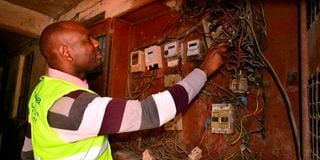Premium
Power price up again on costly fuel, weak shilling

A Kenya Power employee inspects a meter box at an apartment building in Tassia Estate, Nairobi in February 2020.
What you need to know:
- Epra has raised the FCC to Sh7.09 per kilowatt-hour (kWh) up from Sh6.79 last month.
The higher power prices will further push up inflation, which hit a 63-month high of 9.2 percent in September.
Consumers are paying more for electricity after the energy regulator raised the fuel component of power bills for the second consecutive month in effect increasing power prices.
The Energy and Petroleum Regulatory Authority (Epra) has raised the fuel cost charge (FCC) by 4.41 percent in October, a month after increasing it by 46.6 percent due to high fuel costs.
Epra has raised the FCC to Sh7.09 per kilowatt-hour (kWh) up from Sh6.79 last month.
This means a lifeline consumer who bought 62.75 units last month and paid Sh1,209 is now parting with Sh1,238 for the same amount of electricity.
This is the second increase in electricity prices in as many months after having holding stable since December last year.
An increase in the fuel component of electricity brings that cost element close to its record high in a month of Sh9.03kWh that was set in June 2012.
Epra has also raised the foreign exchange rate fluctuation adjustment (Ferfa) by 8.8 percent to Sh1.48 per unit up from Sh1.36 per unit last month after the Kenyan shilling continued to weaken further against the US dollar.
Data from the Kenya National Bureau of Statistics (KNBS) shows high energy costs decelerated the growth of the energy sector to five percent between April and June compared to a 7.2 percent growth in a similar quarter of 2021.
“The growth in the sector was supported by increased generation of electricity from renewable sources such as geothermal and wind that offset the potential detriment associated with an increase in the generation of electricity from thermal sources and a decline in generation from hydroelectric sources,” said KNBS.
The higher power prices will further push up inflation, which hit a 63-month high of 9.2 percent in September.
The high cost of living was driven by a sharp increase in the cost of maize flour, electricity, fuel, and transport in September.
Maize flour prices shot up 8.4 percent between August and September, power prices rose 20.9 percent, petrol prices went up17.7 percent while the cost of transport drove up 25 percent.
Kenya is eyeing alternative sources of energy to cut the share of expensive thermal electricity fed into the system.
While only 7.69 percent of the energy consumed is generated from thermal sources, thermal costs contribute 13 percent of Kenya Power’s entire power purchase costs.
To cut the share of thermal power and enhance reliability of supply, Kenya will start importing cheaper hydroelectric energy from Ethiopia next month.
The two countries officially signed a power purchase agreement (PPA) for the energy supply to Kenya in July.
The deal will see Kenya purchase 200 megawatts from the neighbouring country in the first three years of the 25-year PPA after which the capacity will be stepped up by 400MW.
Kenya is also stepping up plans to denominate PPAs in Kenya shillings to lower the burden of currency depreciation on consumers.





